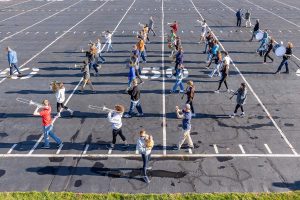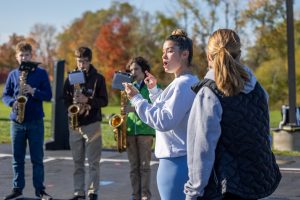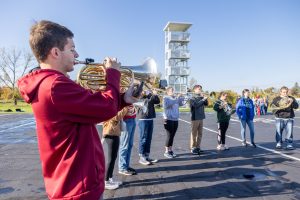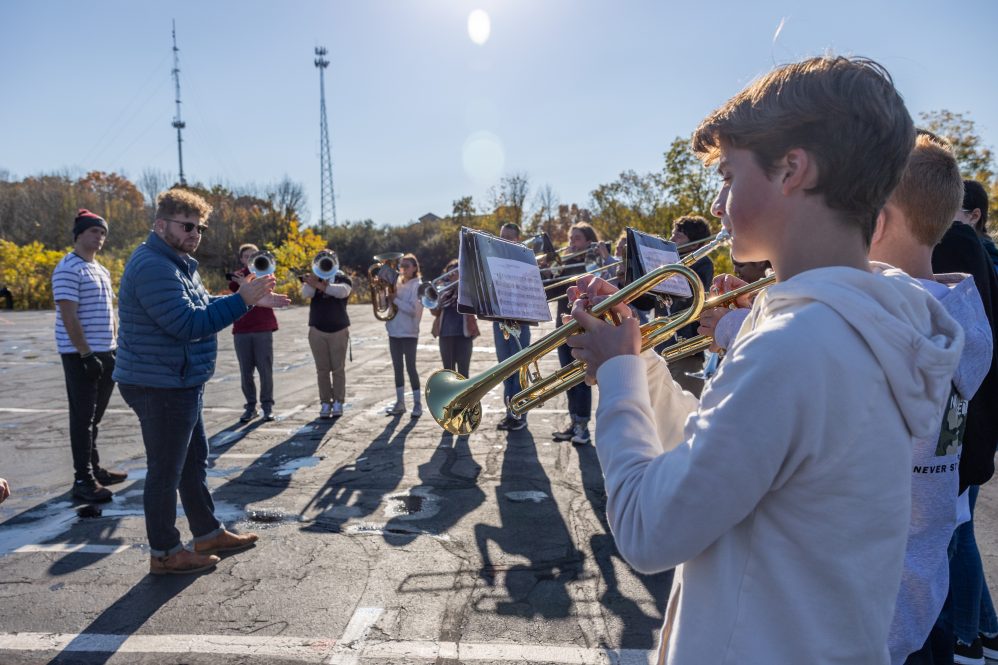In much the same way that drum major Isabelle Allinson ’23 (SFA) commands the attention of the UConn Marching Band, the future music teacher held the interest recently of 25 high schoolers eager to perfect how to simultaneously walk and talk – or in this case, to parade march and play their fight song.
“Give me a forte concert B flat and more brass on this one,” Allinson instructed Stonington High School Marching Band members as they stood at centerfield on the UCMB practice turf.
“We always want to play with a nice volume so everyone can be heard,” she reminded the students. “Remember, we’re outside.”
That means every instrument, from the mild-mannered clarinet to the much louder trumpet, needs to compensate for outdoor acoustics and ambient noise by sounding at full capacity – confidently and competently.

“That was awesome. Nice job,” Allinson complimented the group. “You guys have a nice sound. I’m loving this.”
Most people who attend UConn football games at Pratt & Whitney Stadium at Rentschler Field in East Hartford know the UCMB for its halftime performance and gametime musical pep. Outside game days, though, the band also runs a Make Your Own Band Day program meant to help Connecticut high school marching bands level up.
It’s an endeavor that started nearly two decades ago, when UConn Director of Bands David Mills sought a means to groom young musicians who one day might be Huskies, and a way to give his current student leaders experience teaching their younger peers.
First came a more collective Band Day experience, during which up to 10 high school bands descend on Rentschler Field on game day to practice with the UCMB and perform a short routine alongside them during halftime. Then came a more one-on-one tutorial program, during which a handful of UCMB members visit individual high schools to ready marching bands, mostly for Memorial Day parades.
Finally came the MYOBD program in Storrs, which returned this year after the pandemic, and included visits from schools in Stonington, Branford, Meriden, and other towns on Tuesdays and Thursdays in October.
“Some of the schools have little training as a marching band,” Mills says. “We go out there and teach them how to take a step, how to hold your instrument, how to take a step and hold a whole note. Rather than the director starting from scratch with only three rehearsals to get ready for a parade, we can at least give students the basics and a comfortable, confident beginning.”
Katrina Gottlieb ’03 MA, director of the high school band and a music teacher, has been coming to MYOBD with Stonington High for the last 17 years, always in preparation for its annual march in the Veterans Day parade.
“They look much better after working with the UConn students,” she says. “No matter how much I lecture them about their posture, when they hear it from a college student it makes all the difference. It’s inspirational for the high school students to work with college students.”
And ‘Aweigh’ They Go
After Allinson finished running scales with the young students, UCMB drum major Alexa Crea ’23 (CLAS) set them up in parade block formation at the 10-yard line to play their fight song, “Anchors Aweigh.”
Before they started, UConn Assistant Director of Athletic Bands and Program Coordinator Jessica Von Villas Dickerson ’12 (SFA), ’16 MM wended her way between the high school students, reminding them to lift their chins, look straight ahead, and position the sheet music so their horns didn’t dip down.
“Look great, sound great,” she told them just before they achieved the best rendition that afternoon.

Putting the young marchers on the move came next.
“Everything we do in these clinics is what we do in UCMB,” Dickerson explains, from learning to stabilize the body when it’s in motion to providing consistent airflow into an instrument while on the move. “Anytime we can pair a band like this with UCMB is exciting and unique to a state like this. We want to put out a good image, but it’s also about UConn kids standing among younger kids.”
Dickerson says the MYOBD program at Storrs is malleable based on the needs of the visiting high school. Sometimes they’re readying for a parade, or maybe they want critique on their own halftime show.
“We’re very student centered in the UCMB,” Dickerson says, adding that in much the same way that MYOBD is primarily run by students so aren’t many of the general band functions. “We have to have students who are confident and can carry some of our load.”
Some 300 UConn students strong, the marching band – known as The Pride of Connecticut – doesn’t consist of only music or music education majors. In many cases, students are there simply because they love to play and love the comradery.
And that’s another thing Gottlieb says is important for high school students to learn.
“I have a few students every year who are going on to be music education majors, but I want to just get them to keep playing regardless of what they go on to do,” she says.
Mills: ‘Make band more than a class’
After 33 years as head of the UCMB, through year after year of recruitment and skills building, Mills has advice to high school band directors with programs from novice to competitive – especially as his own retirement looms at the end of this football season.
“A music teacher has to find a way to make band more than a class,” Mills says. “Even if you don’t have a marching band, the band must be active. It must have pride in itself; your teaching isn’t enough no matter how great you are. Find a way for those kids to perform and take pride in what they’re doing.”
He continues, “If your band is inexperienced or small, do easier things. They’re going to be appreciated at the home games just for providing crowd support. Take the band to parades. That’s simpler, and people appreciate the band at parades. Find ways to entertain. If it’s a standstill performance at the mall or in the park, those things can be fun, and people will like them.”
During MYOBD with Stonington High, Allinson, Crea, and Dickerson stepped aside for the last 15 minutes and gave the microphone to Mills for a lesson in the marching band art form that he’s somehow perfected: parade turns.

“Parade turns are the nemesis of the marching band,” he told the high school students as they lined up on a painted straightaway on the practice field.
There are two things – lines and columns – to keep in mind when marching in a parade, he explained. When facing a marching band head on, those are the columns, a long stack of people behind each other. Lines are what the crowd sees from either side and might be only a few people deep.
“If we keep the lines looking good, the band will look good,” he said.
Slowly, and with counted steps, band members followed the painted straightaway that soon curves around the corner edge of the field. The inside column of students inched small steps, while the outmost column took longer steps.
After Stonington rounded one curve, then a second, dozens of UCMB members began to descend on the sidelines to ready for their own practice at the top of the hour, a practice that started with parade practice – with Mills now warmed up and ready.
“We preach that we’re creating a diamond,” Mills says he tells people. “You can’t just polish one facet of a diamond if you want it to shine. You must have every facet polished and clean. You might want to think the top of that diamond is your show, but it’s everything else that makes it shine. It’s how you work, it’s what you look like in the stands, it’s how you sound in the stands, the role you play in the game, and the halftime show. Everything that goes into making the band becomes a facet, and if it’s not good, then you don’t shine and you don’t sparkle.”



